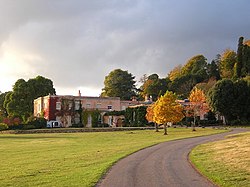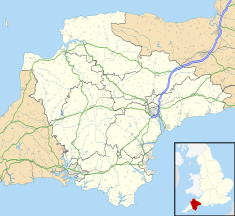| Killerton | |
|---|---|
 Killerton House | |
| Type | Country House |
| Location | Broadclyst |
| Coordinates | 50°47′29″N 3°27′28″W / 50.7915°N 3.4578°W |
| OS grid reference | SS 97349 00089 |
| Area | Devon |
| Built | 1778 |
| Architect | John Johnson |
| Owner | National Trust |
Listed Building – Grade II* | |
| Official name | Killerton House and Ha Ha approximately 20 metres in front of entrance |
| Designated | 11 November 1952 |
| Reference no. | 1098331 |
Listed Building – Grade II* | |
| Official name | The Bear's Hut 220 metres North West of Killerton House |
| Designated | 20 May 1985 |
| Reference no. | 1170706 |
| Official name | Killerton House |
| Designated | 12 Aug 1987 |
| Reference no. | 1000694 |
Killerton is an 18th-century house in Broadclyst, Exeter, Devon, England, which, with its hillside garden and estate, has been owned by the National Trust since 1944 and is open to the public. The National Trust displays the house as a comfortable home. On display in the house is a collection of 18th- to 20th-century costumes, originally known as the Paulise de Bush collection, shown in period rooms.
The estate covers some 2,590 hectares (25.9 km2, 6,400 acres).[1] Included in the estate is a steep wooded hillside with the remains of an Iron Age hill fort on top of it, known as Dolbury, which has also yielded evidence of Roman occupation, namely a triple-ditched Roman fort or marching camp which is still visible in aerial photographs, despite heavy ploughing within the hill fort.[2]
Killerton House itself and the Bear's Hut summerhouse in the grounds are Grade II* listed buildings.[3][4] The gardens are Grade II* listed in the National Register of Historic Parks and Gardens.[5]
- ^ "National Trust - Killerton". web page. National Trust. Retrieved 21 April 2012.
- ^ R.R.Sellman; Aspects of Devon History, Devon Books 1985 - ISBN 0-86114-756-1 - Chapter 2; The Iron Age in Devon. Map Page 11 of Iron Age hill forts in Devon includes Dolbury.
- ^ Historic England. "KILLERTON HOUSE AND HA HA APPROXIMATELY 20 METRES IN FRONT OF ENTRANCE (1098331)". National Heritage List for England. Retrieved 8 June 2014.
- ^ Historic England. "THE BEAR'S HUT 220 METRES NORTH NORTH WEST OF KILLERTON HOUSE (1170706)". National Heritage List for England. Retrieved 8 June 2014.
- ^ Historic England. "Killerton House (1000694)". National Heritage List for England. Retrieved 12 February 2016.
